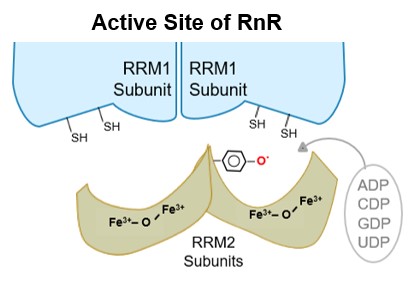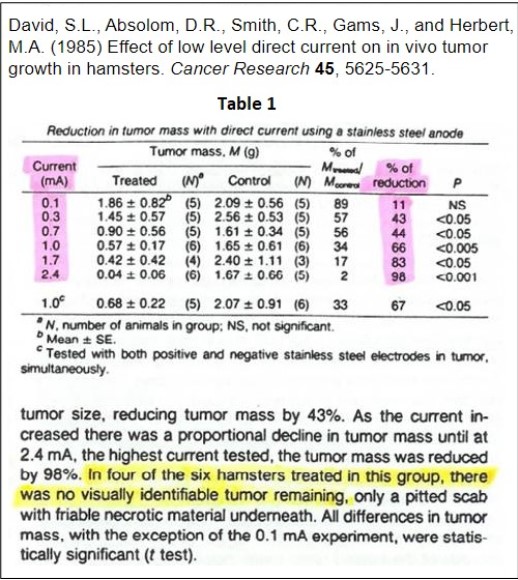Scientific Basis of GEIPE Cancer Therapy
Enzymes control what takes place in a cell. The pivotal enzyme for the synthesis of DNA, and thus for cell growth, is RnR (ribonucleotide reductase) since it supplies building blocks of DNA. Table-1 shows how critical is this enzyme for the growth of cancerous cells. Attempts are continuously being made to synthesize chemotherapeutic drugs that would selectively inhibit this enzyme, but with little success.
A novel way of blocking this enzyme is suggested by the fact that at the "core" (active-site) of this enzyme is a lone electron (free-radical) -- stablized by two Ferric ions -- which is essential for its activity.

Such free radicals can be neutralized or disabled by passing mild direct electric current through the tissue. Fortunately, in healthy cells, the free-radical containing active-site is too well shielded to be destroyed this way, but such does not seem to be the case in cancer cells where mutations abound and the enzyme RnR is in over-drive. Thus, the gentle DC electrotherapy would act selectively on malignant growth.
The connection between low-level DC electrotherapy and deactivation of enzyme RnR was first proposed in 1994. However, use of low-level direct electric currents to treat tumor -- without any clear understanding of the underlying mechanism -- had been reported in scientific literature at least ten times during preceding four decades. Results of all these studies are consistent with the proposed deactivation of the pivotal enzyme.
Outcome reported in three of these papers were very encouraging. For example, a study published in the prominent journal Cancer Research in 1985 reported 98% reduction in the tumor mass of lab animals -- virtual cure -- as shown in the table below:

Remark: On contacting the head scientist Dr. Herbert of the 1985 study, it was discovered that he was denied funding to study the procedure further. Please see his letter in Responses and Inaction of Cancer Institutions'
●●●
Note: Our GEIPE device is best suited for treating visible or palpable tumors like oral cancers (tongue, mouth, palate, lip, neck, throat, buccal mucosa), facial cancers (chin, nose, cheek, head, temple), Merkel cell carcinoma, basal cell carcinoma, squamous cell carcinoma, melanoma, (all skin cancers) some breast cancers and lymphoma. Also, fast-growing prostate cancers. Though entirely scientific, this cancer treatment may be called holistic, complimentary, natural or alternative.